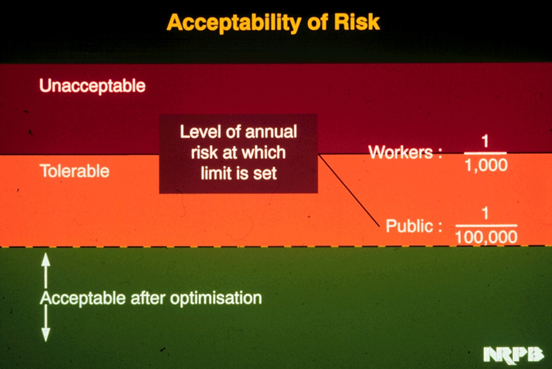Concepts of Risk
Occupational Exposure
- Occupational Exposure 1
- Occupational Exposure 2


Source: NRPB is now the Radiation Protection Division of the HPA
Move your mouse over the image to see a larger version.
It was expected, from data published by ICRP in 1977, that an annual effective whole body dose of 50mSv would lead to a probability of fatal cancer of 0.062% - i.e. that one person in approximately 1600 would die from a single annual dose of 50mSv. This, being less than the predetermined acceptable limit for workers of one in 1000, was adopted as an absolute limit in IRR(1985) (see dose limits in section 1 above).
However, due to reappraisal of the comparison between data from bomb tests carried out in the Nevada desert and data from Hiroshima and Nagasaki, revision has increased the probability of fatal cancer to approximately 0.2% - one in 500 - for an annual effective whole body dose of 50mSv (ICRP 1990). This is not deemed as acceptable throughout a working lifetime and the limits were revised to reflect the changes and these are incorporated into the current legislation.
How big is a millisievert?
- A millisievert is annual public dose limit
- 3 x max. annual dose from nuclear industry discharges
- Less than 1/2 average annual dose from natural radiation in UK
How big is a microsievert?
- 1/10th dose received flying to Spain
- 1/50th dose from a chest x-ray
- 1/5th average annual dose from fallout
- 2 x average annual dose from discharges (existing sites)
Conversely a positron may be created when the nucleus has too many protons to be stable and it is the changing of a proton into a neutron with the subsequent release of a positron particle that accounts for the genesis positrons.
Click on an option.